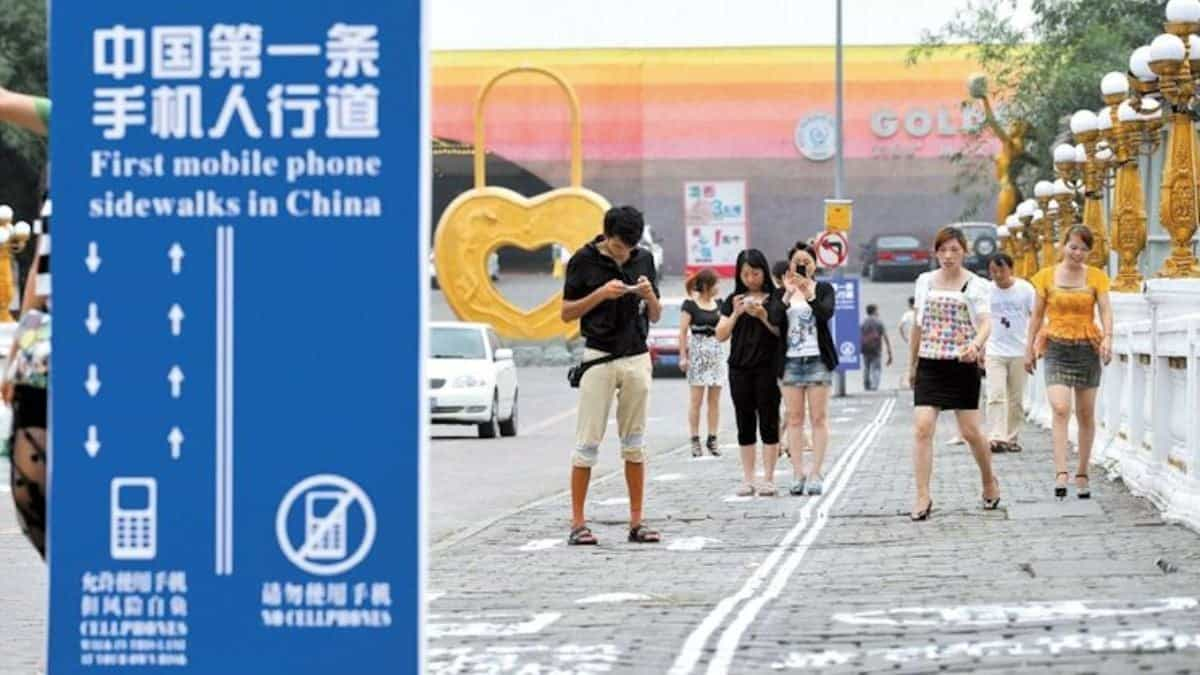Show table of content Hide table of content
When urban design meets smartphone addiction, new creative solutions emerge. In China, a pioneering approach to pedestrian safety is making headlines worldwide. The megacity of Chongqing, home to 32 million residents, has implemented dedicated walking lanes specifically for people who can’t tear their eyes away from their mobile devices. This innovative urban adaptation acknowledges a growing phenomenon that affects cities globally.
Smartphone zombie lanes: a response to modern pedestrian behavior
The sight has become commonplace in urban centers worldwide: pedestrians walking with their attention fully absorbed by smartphone screens. These distracted walkers, dubbed “smombies” (a blend of “smartphone” and “zombie”), navigate public spaces with little awareness of their surroundings. The term originated in 2015 and was even named word of the year by a German dictionary as the behavior became increasingly prevalent.
Chongqing’s response represents perhaps the most direct acknowledgment of this cultural shift. The city has designated specific walking lanes marked for people using their phones while walking. These smartphone lanes exist alongside traditional sidewalks, bike paths, and roadways, creating a segregated space that aims to reduce collisions and improve safety.
China China has released a video of a train traveling at 248 mph, the fastest in the world!
Urban planner Hubert Beroche, founder of think tank Urban AI, observes that this phenomenon signals deeper societal changes. “The proliferation of ‘smombies’ in our streets reveals transformations in our relationship with ourselves, others, and urban spaces,” he explains. Smartphones have created new centralities and movement patterns that urban designers must now consider.
The safety implications of distracted walking
The safety concerns driving these adaptations are substantial. In South Korea, an alarming 61% of pedestrian-related road accidents involve people distracted by smartphones. This statistic underscores why cities are beginning to take this issue seriously. Distracted walking habits significantly impact mental clarity and physical safety, creating hazardous situations for both the walker and others sharing the space.
Beroche noted during his visit to Seoul that the city had installed ground-level traffic signals specifically designed to catch the attention of downward-gazing pedestrians. These lights embedded in crosswalks flash red when it’s unsafe to cross, entering the peripheral vision of smartphone users who might otherwise miss traditional traffic signals.
Walking while fixated on screens increases collision risks with other pedestrians, cyclists, and vehicles. Beyond immediate safety concerns, this disconnection from physical surroundings fundamentally alters how people experience urban environments. The constant digital distraction creates what sociologists describe as “present absence” – physically present in spaces while mentally elsewhere.
Reshaping cities for digital citizens
The introduction of smartphone lanes represents a significant shift in urban design philosophy. Rather than fighting against technological habits, some cities are choosing to accommodate them. This adaptation raises questions about how public spaces should evolve in response to changing behaviors.
Beroche draws a compelling parallel between smartphones and earlier technological revolutions: “The launch of smartphones can be compared to the arrival of automobiles in the 19th century. Many urban planners and architects have studied how technologies transform city materiality. Elevators raised cities upward, subways densified them, and cars stretched them outward.”
The shift from “eyes on the street” to “eyes on the screen” creates new challenges for urban designers. Public spaces traditionally relied on visual engagement and social awareness among users. When significant portions of pedestrians withdraw their attention, the dynamics of shared spaces fundamentally change. These considerations extend beyond walking surfaces to include overlooked areas that require attention such as overhead hazards that distracted walkers might not notice.
The future of pedestrian infrastructure
Chongqing’s smartphone lanes might seem unusual today, but they potentially preview more widespread adaptations. As digital natives become the majority of urban residents, cities worldwide may need to reconsider fundamental aspects of street design. The trend raises important questions about whether infrastructure should adapt to potentially dangerous behaviors or if education campaigns should focus on changing those behaviors.
China China is adopting the hyperloop concept to launch its trains at 620 mph.
Some critics argue that accommodating smartphone zombies normalizes dangerous habits. They suggest resources would be better directed toward campaigns encouraging people to be more present and aware in public spaces. Others contend that pragmatic adaptations reflect realism about human behavior in the digital age.
Beyond dedicated lanes, future adaptations might include embedded sidewalk lighting systems, AI-powered warning systems for approaching hazards, or even automated braking systems for electric scooters and bikes when distracted pedestrians are detected. These technologies would create a more responsive urban environment capable of compensating for divided human attention.
As smartphones become more immersive with augmented reality features, the challenge of keeping pedestrians connected to their physical environment will only grow. The ultimate solution likely involves both technological accommodations and cultural shifts that establish new norms for public space etiquette in the digital age.
Whether Chongqing’s smartphone lanes become a global standard or remain a curiosity, they highlight an important reality: as technology reshapes human behavior, urban environments must evolve in response. The walkable city of tomorrow may look quite different from today’s, designed with awareness that many pedestrians now navigate dual realities – one physical, one digital – simultaneously.
China China: Two tourists flash their buttocks on the Great Wall and end up behind bars.


